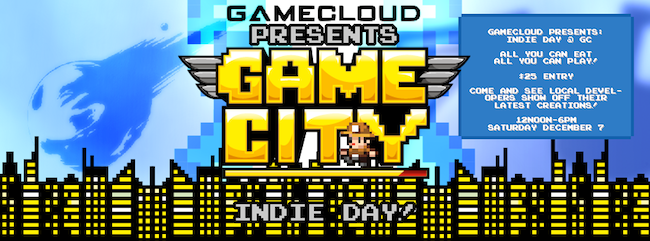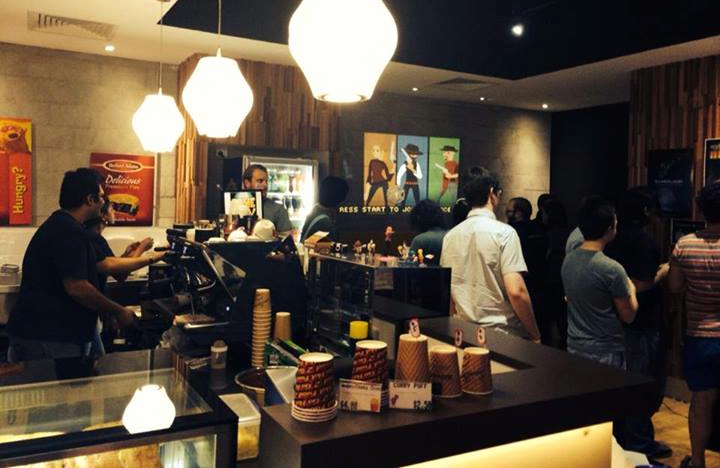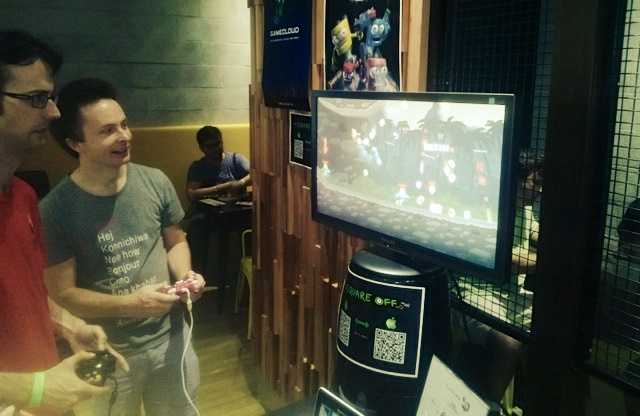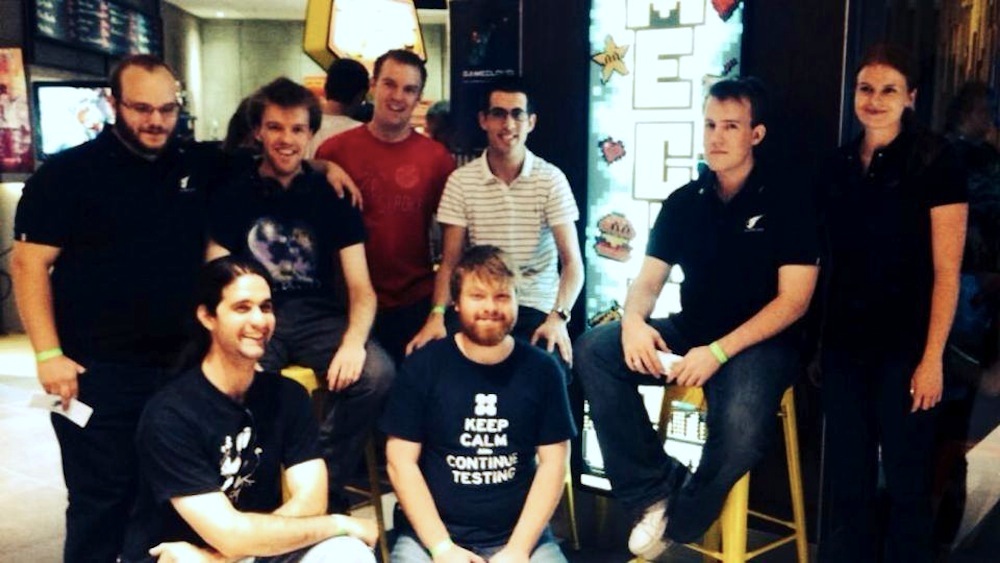
Wow… Just wow. In a day and age involving sky-rocketing rental prices with unreasonable landlords, plus the slow and agonising death of video game arcade culture, as well as the absence of any significant gaming or general entertainment industry presence, my cynical self was left feeling like Perth was stuck to be the perpetual cultural wasteland. You’re more likely to see a crowd of hi vis-clad workmen shuffling in and out of building sites and airports, as well as overpriced, mediocre coffee, rather than the rising star of local creative talent.
Upon arriving at Game City, that cynical lens was promptly blasted out of my skull by the shotgun-shell of awesomeness on showcase- I’d hate to admit it, but I really had no idea we had such a developed level of home-grown game-designing talent right in our own backyard! But my sentiments aside, I spent some time chatting with the game designers, and playing their creations, as well as checking out what’s shaping up to be the newest gaming joint in town so here are my thoughts (I’d also like to offer my sincerest apologies to the designers whose games I did not get to play – there was simply too much on for me to give equal attention to everything, but do not despair, keep Game Cloud posted on your work and we’ll be on to it as soon as possible!)
Game City: The brainchild of Dharmesh Patel, who previously graced the Carillion Arcade with the Game Traders store, has returned for a new venture as a fixture of Perth’s now-cranking gaming community- combining the qualities of an arcade, a cafe, and a casual hangout for folks of all ages, Game City is shaping up to be Perth’s oasis of all things gaming. I was impressed with the spreads laid out, including some great subway-style sandwiches, very tasty pizzas, hot-dogs and more types of soda than you could shake a Wii-mote at.

I had the joy of checking out another SK Games project the previous week, and from that I got a sense of their general vision of gaming, being something that should be simple, fun, and accessible to all, played out on their arcade-style machines designed and built by them for the ground up. This time, I got to try out their latest offering, a little oddity called ‘Gun Dash’- a simultaneous, four-player race through an obstacle course to a finish line. However the key mechanic that makes this game what it is is the titular ‘gun’ that each character is equipped with. The guns come pre-loaded with six bullets and function more as a tool to manipulate physics than a weapon to bring down the other players (though scoring a hit will incapacitate the player).
The gun’s main function is to violently propel the player in the opposite direction from which it was fired, ie: shooting down propels you up, shooting left propels you right. My first thought was that this would make for some amazing speed-run replays, and I am hoping a future release does include some features for recording/remotely saving/uploading replays, as I feel this would grant the game appeal beyond the casual audience and garner a hardcore competitive following.

The only gripes I had with this offering was the controls, and somewhat floaty, inconsistent physics within the game. Gun Dash is controlled by two joysticks, one for movement, the other for firing the gun (tapping the joystick in one of the four cardinal directions will fire a shot in that direction). I found the directional tolerance to be a little loose on the joystick, and it was easy to misfire- then again, this could be partly due to my own lack of coordination with joysticks. Perhaps this was to add to the challenge factor of the game, but I personally would feel more comfortable with a binary set of four directional arrows to control the shooting. Additionally, the nature of physics (more specifically, the obscure behaviour of gravity when players ‘climb’ up walls) felt jarring to the pace of the game.
However, on the whole it had a fairly well paced flow, and I found the artistic style to be quite appealing, with the character art rendered in a style of polygonal, flat-shaded vector art in earthy brown pallet, very much befitting of the ‘wild west’ theme. To top off the design, the “controllers” were built as large, free-standing solid wood ‘bar stools’ with a cow-skin upholstery. Very stylish indeed!
So to conclude, this could certainly be a popular party game, with great potential to garner a hardcore following. With a few minor tweaks to the physics and perhaps some options to save replays, as well as a map maker function, this could really take off.
The lads from Stirfire Studios had a nice set-up, complete with 1080p monitor and a Xbox 360 controller to showcase their latest project- Freedom Fall. I spent a fair bit of time playing through the demo, and getting a sense of the kind of game I’m looking at here. I for one rejoiced the triumphant return of 2D platform gaming in recent years; I feel that this was in part helped by a growing sense of ‘FPS fatigue’ among gamers, and we found ourselves yearning for simpler, more enjoyable game-play akin to so many of the games that originally developed our sense of what a ‘game’ is.
My initial impression of the game was that it was something like Super Mario Bros. 2 crossed with the original Prince of Persia as combat/environmental manipulation mainly revolved around bombs that were found, picked up and thrown, while there was also a degree of acrobatic competency to the environmental navigation. A policy of one-hit-death is in place, but this is balanced out by a fairly forgiving dash of frequent checkpoints. When I asked the developers who their target audience was, they assured me that while the demo levels are quite easy, the difficulty does, in fact, ramp up significantly in later stages.
I quite liked the in-game currency system (being an assortment of nuts, bolts and gears of varying values) that could be exchanged for tools to help navigate the world. The only tool I was able to unlock was the hang-glider. I found its integration somewhat clever, with former hazards (large fire pots) now proving to be quite useful as you are able to ride updraughts to access new areas of the map. This has great potential for a ‘Metroidvania’ type of game, but I don’t sense the developers are going for that style as the environmental navigation proves too linear.

I also found the artistic style, and environmental storytelling to be quite pleasing- from the outset, you are offered practically no exposition, other than the scribbles that follow you across the walls. These scribbles offer expository plot elements, often delivered with a dark and deviant sense of humour. I liked them. It gave the world and off-screen characters some charm that’s often lacking in platform games. Artistically, Freedom Fall looks beautiful, with bright, garish colours and an overall ‘steampunk gone mad’ theme, this was a real eyeball feast. Musically, the game stood up very well, with some cool ambient tones set to a catchy toe-tapping rhythm with some middle-eastern influenced grooves over the top. It sounds cool and unique.
However, I felt in terms of game-play, there wasn’t a lot new on offer to the platform genre- with an absence of traditional platform gaming ‘enemies’, the only threats present are environmental, which could be confusing for some players; while I feel that there’s more to this game than the demo has shown me, I’m still unsure of what Freedom Fall is trying to be. All the same, I’m looking forward to getting my hands on this one when it comes out.
Gnomic Studios: These guys had a prime position right at the entrance, and their offering was nothing short of fantastic- Square Heroes is deceptively simple in appearance, as players control a personified geometric square on a 2D plane with a full degree of freedom in movement. This deceptively simple exterior hides an extraordinary finely tuned, well-balanced experience with an intuitive ammunition system, snappy, responsive controls and weapons that give you a real sense of power.
Granted, I only played a couple of multi-player rounds, but I got a sense that the folks over at Gnomic Studios spent a lot of time play-testing, play-testing, and play-testing some more. Essentially, Square Heroes is a 2D shooter with full-axis movement- that is, players are not restricted by Gravity and ‘float’ at will around the arena, happily blasting to pieces anything the ensuing alien (or enemy player) horde. I also use the term ‘float’ loosely, because for squares floating in space, the control was surprisingly tight and responsive, with some clever aiming mechanics. This is predominantly a 2-stick game, with one stick for movement, the other for aiming. When enemies are killed, a series of gems are dropped, and when a certain number is collected, new guns are automatically unlocked.

I thought this was particularly clever though as new guns, while more powerful, will also chew through your ammo faster, so there’s always a sense of balance present in the game- Your biggest gun is not necessarily the best, and this kind of balance is also a hallmark of good design, as it helps curb exploitation of overpowered weaponry.
Perhaps the most heart-warming feature of Square Heroes to me, was the fact it supported out-of-the-box local multi-player, where up to four players could pick up a controller and blast each other to pieces. It’s a feature that hearkens back to the golden days of console gaming; kids of the future will never know the joys of having a bunch of friends over, everyone picking up a controller, and throwing down with your friends in the room; pouring out soda after soda, eating packets of chips, having a laugh with your mates at some downright ridiculous moments; there was nothing quite like it, and it’s a far cry from today’s multi-player gaming which sometimes doesn’t even ship stock with some games, and may require extensive updating/DLC to actually function, as well as a fast, reliable internet connection.
Having said that, Gnomic Studios aren’t limiting Square HEroes to local multi-player only; they have plans to support up to 16 players simultaneously for death-matching. I’m looking forward to seeing where this one goes!
Last but not least, I got to catch up with Anthony Sweet, the local mastermind behind the soon-to-be-released board-game ‘Halflings Heist’; the game is 2-4 players and plays out on a board similar in size to a chess board. I was immediately wrapped when I learned that this game was set during a fantasy-kingdom bar brawl; I never, in my wildest dreams, could come up with a scenario so insanely hilarious-sounding, and thus, I was eager to play it!
Though my literacy of Fantasy is loose at best, I get a sense that halflings are more or less the underclass of society- they have a hard time getting jobs, get fired easily and are more or less scrounging for food on a regular basis- that’s where the heist comes in! A pub brawl has just broken out, and the opportunistic halflings have only one thing on their minds- to swipe as much food as they possibly can from under the preoccupied patrons’ noses and escape before the City Watch come to arrest you.
Essentially, that’s the premise, but how well does it play out as a game? Pretty damn well as it turns out! The pacing is fast, with fairly clear, easily understood rules. Essentially, most of the board is live space, where events constantly happen as dictated by the ‘brawl’ cards which are drawn on every move to a live square. The consequences of these cards are sometimes beneficial, and sometimes detrimental to the player. They also function as something of a ‘timer’ to the game-play, as once the deck of ‘brawl’ cards are drawn, the game is over. A second deck of cards also exists, called ‘luck’ cards- though players do not draw a hand, the luck cards are collected by players as dictated to them by certain brawl card conditions. These cards go into the player’s ‘hand’ and can be used at a later instance if they so wish.

Other areas of the board include the tables, which is the ‘spawn point’ for food to be collected (food re-spawns from a ‘brawl’ card event). They are also a little safer than the live floor space as the player can move freely, though they are not immune from certain brawl events affecting the table spaces.
Lastly, I found the scoring system to be quite intuitive- each food item is worth a certain point value, however, if players collect a certain combination of food items (certain ‘meal’ combinations) they are eligible for point bonuses; however, the foods used in these ‘meals’ do not stack with other ‘meals’ you may wish to produce, so be sure to concoct the most rewarding meal when it’s tallying time!
I thoroughly enjoyed Halflings Heist, and my only gripe was the fact that the game was sold out by the time I got to play it! It was a thoroughly enjoyable, well-paced game that’s suited to quick and enjoyable replays as well as some balanced competitive mechanics. I’m sure someone’s going to come up with some drinking game rules to this sooner or later, and I hope I’m there when it kicks off!
I can safely say that I walked away with my faith not only restored in Perth, but with a new-found sense of optimism that we can, and will be, making our mark on the wonderful interactive world of gaming very, very soon.












